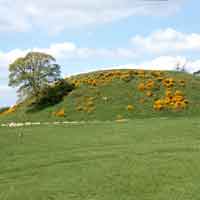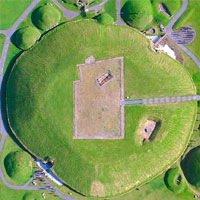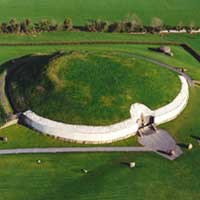Boyne Valley Complex

Location: Glebe, Co. Meath
Classification: Ancient Complex
Rating:
The megalithic complex located within the bend of the River Boyne contains one of the world's most important prehistoric landscapes. The Boyne Valley Complex is dominated by the three huge passage tombs, Newgrange, Knowth and Dowth, built some 5,000 years ago in the late Neolithic c.3200BCE. An additional ninety monuments have been recorded in the area giving rise to one of the most significant archaeological complexes in terms of scale and density of monuments and the material evidence that accompanies them. The Boyne Valley tombs, in particular, Knowth, contain the largest assemblage of megalithic art in Western Europe. The complex was inscribed as a World Heritage Site in December 1993 in recognition of its outstanding universal value. The scale of passage tomb construction, the important concentration of megalithic art as well as the range of sites and the long continuity of activity were cited as reasons for the site's inscription.
The construction of the passage tombs in the Boyne Valley commenced sometime around 3200 BC. The construction of at least 40 passage tombs displaying a sophisticated knowledge of architecture, engineering, astronomy and artistic endeavour indicates a highly organised and settled society with highly complex rituals and ceremonies surrounding the treatment of the dead and contact with the ancestors. When the tombs fell into disuse, possibly around 2700 BC, the areas surrounding them continued to be the focus of ceremonies, ritual and habitation right through to the Iron Age. Evidence of this activity, includes Late Iron Age, Roman items of high value, including coins and jewellery, which were deposited in the vicinity of Newgrange as votive offerings.
Boann is the Irish goddess figure who, according to the myths, created the river Boyne, one of the sacred rivers of ancient Ireland. Her name is interpreted as 'white cow' from the Old Irish, 'Bó Find'. Interestingly, the earliest surviving geographical description of Ireland (Ptolemy's 2nd century "Geographia") gives the river's name as 'Bouwinda', which likely derives from Proto-Celtic word *Bou-vindā, also meaning 'white cow'. When Boann approached the forbidden Well of Knowledge (also known as 'Nechtáns Well' or 'Well of Segais'), the water rose up against her. Boann was swept by the torrent all the way to the sea, gaining the knowledge she desired but losing her mortal life by becoming the river that is named after her - The Boyne.
Description
The megalithic complex located within the bend of the River Boyne contains one of the world's most important prehistoric landscapes. The Boyne Valley Complex is dominated by the three huge passage tombs, Newgrange, Knowth and Dowth, built some 5,000 years ago in the late Neolithic c.3200BCE. An additional ninety monuments have been recorded in the area giving rise to one of the most significant archaeological complexes in terms of scale and density of monuments and the material evidence that accompanies them. The Boyne Valley tombs, in particular, Knowth, contain the largest assemblage of megalithic art in Western Europe. The complex was inscribed as a World Heritage Site in December 1993 in recognition of its outstanding universal value. The scale of passage tomb construction, the important concentration of megalithic art as well as the range of sites and the long continuity of activity were cited as reasons for the site's inscription.
History
The construction of the passage tombs in the Boyne Valley commenced sometime around 3200 BC. The construction of at least 40 passage tombs displaying a sophisticated knowledge of architecture, engineering, astronomy and artistic endeavour indicates a highly organised and settled society with highly complex rituals and ceremonies surrounding the treatment of the dead and contact with the ancestors. When the tombs fell into disuse, possibly around 2700 BC, the areas surrounding them continued to be the focus of ceremonies, ritual and habitation right through to the Iron Age. Evidence of this activity, includes Late Iron Age, Roman items of high value, including coins and jewellery, which were deposited in the vicinity of Newgrange as votive offerings.
Folklore
Boann is the Irish goddess figure who, according to the myths, created the river Boyne, one of the sacred rivers of ancient Ireland. Her name is interpreted as 'white cow' from the Old Irish, 'Bó Find'. Interestingly, the earliest surviving geographical description of Ireland (Ptolemy's 2nd century "Geographia") gives the river's name as 'Bouwinda', which likely derives from Proto-Celtic word *Bou-vindā, also meaning 'white cow'. When Boann approached the forbidden Well of Knowledge (also known as 'Nechtáns Well' or 'Well of Segais'), the water rose up against her. Boann was swept by the torrent all the way to the sea, gaining the knowledge she desired but losing her mortal life by becoming the river that is named after her - The Boyne.
View all Monuments within this Complex
View all Monuments within this Complex
Accessibility Rating: Easy
Admission to Newgrange and Knowth is through the Brú na Bóinne Visitor Centre, Donore, Co. Meath, there is no direct access to these monuments. Only Dowth is directly accessible.
The Brú na Bóinne Visitor Centre, Donore, Co. Meath.
Telephone No: +353 41 988 0300.
Accessibility
Accessibility Class: Easy
Admission to Newgrange and Knowth is through the Brú na Bóinne Visitor Centre, Donore, Co. Meath, there is no direct access to these monuments. Only Dowth is directly accessible.
Facilities
The Brú na Bóinne Visitor Centre, Donore, Co. Meath.
Telephone No: +353 41 988 0300.
Map
Users should note that the Monumental Ireland application and website are information guides only and do not act as an invitation to enter any of the properties or sites listed. No responsibility is accepted by the creators of the Monumental Ireland application for any loss, injury or inconveniences sustained as a result of using it.












